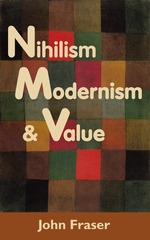
About the Author: John Fraser
JOHN FRASER is the author of Violence in the Arts (1974), America and the Patterns of Chivalry (1982), and The Name of Action; Critical Essays (1985), all published by Cambridge University Press, and of numerous articles in journals, amog them the Partisan Review, Southern Review, Yale Review, Cambridge Quarterly, and Studio International. He did the article on 20th-century American and British poetics in the 1964 edition of the Princeton Encyclopedia of Poetry and Poetics. His website, www.jottings.ca contains the equivalent of several more books, including the major revisionist anthology A New Book of Verse.
He was born in North London, educated in a provincial grammar school, and, after his two years of National Service in the R.A.F. (clerical), entered Balliol College, Oxford, as an Exhibitioner (junior scholar). Subsequently he obtained a Ph.D. in English at the University of Minnesota, with a Philosophy minor, including classes from Alan Donagan and Wilfred Sellars. He taught for thirty years at Dalhousie University, retiring as George Munro Professor, of English, and in 1991 gave the Alexander Lectures at the University of Toronto. He was married to the artist Carol Hoorn Fraser. He is in Wikipedia as John Fraser (critic).
Critics found his widely-reviewed Violence in the Arts "both scholarly and extraordinarily interesting" (New Repubc), "compellingly readable" (Film Review Annual), "continuously stimulating" (Economist), "profoundly illuminating" (Psychology Today), "brilliant" (Los Angeles Times), "an extremely agile and incessantly active mind which illuminates almost every subject it touches" (Spectator).
A senior reviewer of America and the Patterns of Chivalry in the Yearbook of English Studies called it "a brilliant and utterly absorbing work. There are not many learned books which have the unputdownable quality of a thriller; this is one of them.... None, I think, can read his book without profit, and certainly nobody will be bored." The reviewer for the Times Literary Supplement found its documentation "awesome."

Nihilism, Modernism, and Value consists of three jargon-free lectures addressed to the general reader. It explores a variety of ways in which writers responded to the phenomenon of nihilism in the 19th and early 20th centuries, By "nihilism" here is meant a sense, at times paralyzing, of the instability and perhaps groundlessness of all values. The book goes into some of the factors— psychological, sociological, philosophical—involved in that destabilizing. But its principal focus is on reintegration, and it draws freely on real-world experiences to illuminate concepts and strategies.
Among the writers whose names figure in it are Conrad, Nietzsche, Beckett, Woolf, Heidegger, Rhys, Pushkin, Baudelaire, Hemingway, Lessing, Stevens, Valéry, and James (William), with particular attention at one point to Kafka and Borges. But no prior knowledge of them is required for following the argument, with its numerous lively quotations. The author himself is advancing heuristically, not just performing an academic exercise. The problems confronted are as relevant still as they were generations ago.
A reviewer of John Fraser's first book spoke of "an extremely agile and incessantly active mind which illuminates almost every subject it touches." A reviewer of the second one, both of them published by Cambridge University Press, called it "a brilliant and utterly absorbing work," and said that "There are not many learned books which have the unputdownable quality of a thriller; this is one of them."
 Nihilism, Modernism, and Value consists of three jargon-free lectures addressed to the general reader. It explores a variety of ways in which writers responded to the phenomenon of nihilism in the 19th and early 20th centuries, By "nihilism" here is meant a sense, at times paralyzing, of the instability and perhaps groundlessness of all values. The book goes into some of the factors— psychological, sociological, philosophical—involved in that destabilizing. But its principal focus is on reintegration, and it draws freely on real-world experiences to illuminate concepts and strategies.
Nihilism, Modernism, and Value consists of three jargon-free lectures addressed to the general reader. It explores a variety of ways in which writers responded to the phenomenon of nihilism in the 19th and early 20th centuries, By "nihilism" here is meant a sense, at times paralyzing, of the instability and perhaps groundlessness of all values. The book goes into some of the factors— psychological, sociological, philosophical—involved in that destabilizing. But its principal focus is on reintegration, and it draws freely on real-world experiences to illuminate concepts and strategies.